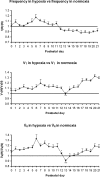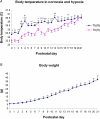Postnatal changes in ventilation during normoxia and acute hypoxia in the rat: implication for a sensitive period
- PMID: 17038423
- PMCID: PMC1890370
- DOI: 10.1113/jphysiol.2006.121970
Postnatal changes in ventilation during normoxia and acute hypoxia in the rat: implication for a sensitive period
Abstract
Previously, we found heightened expression of inhibitory neurochemicals and depressed expression of excitatory neurochemicals with a sudden drop in metabolic activity around postnatal day (P) 12 in rat brainstem respiratory nuclei, suggesting that this period is a critical window during which respiratory control or regulation may be distinctly different. To test this hypothesis, the hypoxic ventilatory responses (HVR) to 10% oxygen were tested in rats every day from P0 to P21. Our data indicate that (1) during normoxia (N), breathing frequency (f) increased with age, peaking at P13, followed by a gradual decline, whereas both tidal volume (V(T)) and minute ventilation (.V(E) ) significantly increased in the second postnatal week, followed by a progressive increase in V(T) and a relative plateau in .V(E); (2) during 5 min of hypoxia (H), .V(E) exhibited a biphasic response from P3 onward. Significantly, the ratio of .V(E)(H) to .V(E)(N) was generally > 1 during development, except for P13-16, when it was < 1 after the first 1-2 min, with the lowest value at P13; (3) the H : N ratio for f, V(T) and .V(E) during the first 30 s and the last minute of hypoxia all showed a distinct dip at P13, after which the V(T) and .V(E) values rose again, while the f values declined through P21; and (4) the H : N ratios for f, V(T) and .V(E) averaged over 5 min of hypoxia all exhibited a sudden fall at P13. The f ratio remained low thereafter, while those for V(T) and .V(E) increased again with age until P21. Thus, hypoxic ventilatory response is influenced by both f and V(T) before P13, but predominantly by V(T) after P13. The striking changes in normoxic ventilation as well as HVR at or around P13, together with our previous neurochemical and metabolic data, strongly suggests that the end of the second postnatal week is a critical period of development for brainstem respiratory nuclei in the rat.
Figures







Similar articles
-
Neurochemical and physiological correlates of a critical period of respiratory development in the rat.Respir Physiol Neurobiol. 2008 Dec 10;164(1-2):28-37. doi: 10.1016/j.resp.2008.04.014. Respir Physiol Neurobiol. 2008. PMID: 18524695 Free PMC article. Review.
-
Postnatal development of metabolic rate during normoxia and acute hypoxia in rats: implication for a sensitive period.J Appl Physiol (1985). 2009 Apr;106(4):1212-22. doi: 10.1152/japplphysiol.90949.2008. Epub 2008 Dec 31. J Appl Physiol (1985). 2009. PMID: 19118157 Free PMC article.
-
Ventilatory and carotid body responses to acute hypoxia in rats exposed to chronic hypoxia during the first and second postnatal weeks.Respir Physiol Neurobiol. 2020 Apr;275:103400. doi: 10.1016/j.resp.2020.103400. Epub 2020 Jan 30. Respir Physiol Neurobiol. 2020. PMID: 32006667 Free PMC article.
-
Role of cholinergic-nicotinic receptors on hypoxic chemoreflex during postnatal development in rats.Respir Physiol Neurobiol. 2009 Dec 31;169(3):323-32. doi: 10.1016/j.resp.2009.09.014. Epub 2009 Oct 7. Respir Physiol Neurobiol. 2009. PMID: 19818418
-
The ventilatory response to hypoxia in mammals: mechanisms, measurement, and analysis.Physiol Rev. 2010 Apr;90(2):675-754. doi: 10.1152/physrev.00012.2009. Physiol Rev. 2010. PMID: 20393196 Review.
Cited by
-
Excitatory-inhibitory imbalance in hypoglossal neurons during the critical period of postnatal development in the rat.J Physiol. 2011 Apr 15;589(Pt 8):1991-2006. doi: 10.1113/jphysiol.2010.198945. Epub 2011 Feb 28. J Physiol. 2011. PMID: 21486774 Free PMC article.
-
Postnatal changes in the expressions of serotonin 1A, 1B, and 2A receptors in ten brain stem nuclei of the rat: implication for a sensitive period.Neuroscience. 2010 Jan 13;165(1):61-78. doi: 10.1016/j.neuroscience.2009.09.078. Epub 2009 Oct 2. Neuroscience. 2010. PMID: 19800944 Free PMC article.
-
Neurochemical and physiological correlates of a critical period of respiratory development in the rat.Respir Physiol Neurobiol. 2008 Dec 10;164(1-2):28-37. doi: 10.1016/j.resp.2008.04.014. Respir Physiol Neurobiol. 2008. PMID: 18524695 Free PMC article. Review.
-
Peripheral-central chemoreceptor interaction and the significance of a critical period in the development of respiratory control.Respir Physiol Neurobiol. 2013 Jan 1;185(1):156-69. doi: 10.1016/j.resp.2012.05.026. Epub 2012 Jun 8. Respir Physiol Neurobiol. 2013. PMID: 22684042 Free PMC article. Review.
-
Effects of neonatal hyperoxia on the critical period of postnatal development of neurochemical expressions in brain stem respiratory-related nuclei in the rat.Physiol Rep. 2018 Mar;6(5):e13627. doi: 10.14814/phy2.13627. Physiol Rep. 2018. PMID: 29516654 Free PMC article.
References
-
- Berquin P, Cayetanot F, Gros F, Larnicol N. Postnatal changes in Fos-like immunoreactivity evoked by hypoxia in the rat brainstem and hypothalamus. Brain Res. 2000;877:149–159. - PubMed
-
- Bissonnette JM. Mechanisms regulating hypoxic respiratory depression during fetal and postnatal life. Am J Physiol Regul Integr Comp Physiol. 2000;278:R1391–R1400. - PubMed
-
- Blanco LN. Mechanisms for the generation of gas-exchange surface area in rat lung. Am J Physiol Lung Cell Mol Physiol. 1995;269:L698–L708. - PubMed
Publication types
MeSH terms
LinkOut - more resources
Full Text Sources
Medical

